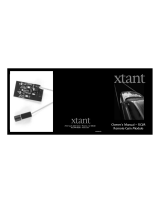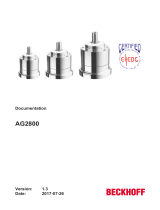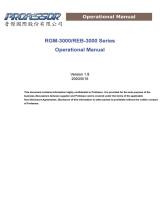
RGM
®
User Manual
Edition: B, February 2019
Part Number:903-800006-00
Original Documentation
For safe and proper use, follow these instructions.
Keep them for future reference.

Record of Document Revisions
Revision Remarks
A, 10/2017 Launch version
B, 6/2018 RGM-C
Trademarks
l EtherCAT is a registered trademark and patented technology, licensed by Beckhoff Automation
GmbH
l Windows is a registered trademark of Microsoft Corporation
Current patents
l US Patent 8,154,228 (Dynamic Braking For Electric Motors)
l US Patent 8,214,063 (Auto-tune of a Control System Based on Frequency Response)
Patents referring to fieldbus functions are listed in the matching fieldbus manual.
Technical changes which improve the performance of the device may be made without prior notice!
Printed in the United States of America
This document is the intellectual property of Kollmorgen. All rights reserved. No part of this work may be
reproduced in any form (by photocopying, microfilm or any other method) or stored, processed, copied or
distributed by electronic means without the written permission of Kollmorgen.
RGM User Manual |
Kollmorgen | kdn.Kollmorgen.com | February 2019 2

This page intentionally left blank.
RGM User Manual |
3 Kollmorgen | kdn.Kollmorgen.com | February 2019

1 Table of Contents
1 Table of Contents 4
2 Introduction to RGM 5
2.1 General 6
2.1.1 About this manual 6
2.2 Safety 7
2.2.1 You should pay attention to this 7
2.3 Package 7
2.3.1 Delivery Package 7
2.4 Important Brake Usage Guidelines 8
3 Power Supply Voltage & Current Ratings 9
4 Maximum Speed 10
5 Torque Ratings 11
6 Duty Cycle 12
7 Rotation Limits 13
8 Accuracy & Repeatability 14
9 Maximum Thermal Ratings 15
10 Monitoring Thermistor 16
11 Brake Function & Manually Releasing the Brake 17
11.1 About the Brake Function 17
11.2 Manually Releasing the Brake 17
12 Bolting Joint-to-Joint, Mounting Screws 19
13 Environmental Requirements 20
14 IP Rating 21
15 Joint-to-Joint Plastic Rings & Rubber Bands 22
16 Rear Cover Removal & Daisy Chain Connections 24
17 Daisy Chain Wire Sizes, Colors, and Functions 27
18 RGM Workbench Software & Drive Commissioning 28
19 Serial Cable Part Number 29
20 CANopen Termination 30
21 Brake Initialization 31
21.1 RGM Enable/ Brake Initialization Procedure 31
22 Regeneration Warning 32
23 End Effectors 33
24 Board Layout 34
24.1 CANopen 34
24.2 EtherCAT 35
25 Data Sheets 36
25.1 RGM14 37
25.2 RGM17 38
25.3 RGM20 39
25.4 RGM25 40
26 Index 41
RGM User Manual | 1 Table of Contents
Kollmorgen | kdn.Kollmorgen.com | February 2019 4

2.1 General
2.1.1 About this manual
This manual describes the RGM robotic joint modules. Each RGM combines a frameless torque motor, low
voltage DC drive, brake, strain wave gear, dual feedback system, and a thermal sensor in a single joint
assembly to be used in a robot configuration. Please review the entire manual which includes information on:
l Power
l Speed and Torque Ratings
l Duty Cycle
l Rotation Limits
l Thermal Ratings and Monitoring Thermistor
l Brake Function
l Installation and Mounting
l Rear Cover Removal and Daisy Chaining
l Wiring
l RGMEWV
l CANopen
l End Effectors
RGM User Manual | 2 Introduction to RGM
Kollmorgen | kdn.Kollmorgen.com | February 2019 6

RGM User Manual | 2 Introduction to RGM
2.2 Safety
This section helps you to recognize and avoid dangers to people and objects.
2.2.1 You should pay attention to this
Specialist staff required!
Only properly qualified personnel are permitted to perform such tasks as transport, assembly, setup and
maintenance. Qualified specialist staff are persons who are familiar with the transport, installation, assembly,
commissioning and operation of motors and who bring their relevant minimum qualifications to bear on their
duties:
l Transport: only by personnel with knowledge of handling electrostatically sensitive components.
l Mechanical Installation: only by mechanically qualified personnel.
l Electrical Installation: only by electrically qualified personnel.
l Setup: only by qualified personnel with extensive knowledge of electrical engineering and drive tech-
nology
The qualified personnel must know and observe IEC 60364 / IEC 60664 and national accident prevention
regulations.
Read the documentation!
Read the available documentation before installation and commissioning. Improper handling of the motor can
cause harm to people or damage to property. The operator must therefore ensure that all persons entrusted to
work on the motor have read and understood the manual and that the safety notices in this manual are
observed.
Pay attention to the technical data!
Adhere to the technical data and the specifications on connection conditions (rating plate and documentation).
If permissible voltage values or current values are exceeded, the motors can be damaged, for example by
overheating.
Perform a risk assessment!
The manufacturer of the machine must generate a risk assessment for the machine, and take appropriate
measures to ensure that unforeseen movements cannot cause injury or damage to any person or property.
Additional requirements on specialist staff may also result from the risk assessment.
Transport safely!
Lift and move motors with more than 20 kg weight only with lifting tools. Lifting unassisted could result in back
injury.
Hot surface!
The surfaces of the motors can be very hot in operation, according to their protection category. Risk of minor
burns! The surface temperature can exceed 100°C. Measure the temperature, and wait until the motor has
cooled down below 40°C before touching it.
2.3 Package
2.3.1 Delivery Package
l Joint from the RGM series
l Thermal precaution instructions
7 Kollmorgen | kdn.Kollmorgen.com | February 2019

2.4 Important Brake Usage Guidelines
The RGM brake is designed for use as a static holding brake (park brake) only. It is not intended to be used
as a dynamic brake or to be suddenly engaged while the RGM is moving. Permanent damage to brake
assembly components may occur if brake is engaged while still in motion.
During controller and application software development, software bugs may cause trajectory errors or other
types of errors. These errors may trigger unexpected events that cause the drive to fault and disable,
suddenly engaging the brake while RGM is in motion. To avoid accidental damage, it is recommended during
development activities that users configure the fault event actions using RGM Workbench to “NONE” or set
the range where the event is triggered to a value that is well outside normal operation. Fault event actions can
be reset to operational values after the development process is complete and the risk of accidental brake
damage is minimized.
The user must determine whether the loss of functionality and lack of fault monitoring to protect the brake
during development activities warrants the risk of increasing operational and safety concerns.
For assistance in disabling fault events, please contact Kollmorgen Applications Engineering.
RGM User Manual | 2 Introduction to RGM
Kollmorgen | kdn.Kollmorgen.com | February 2019 8

RGM User Manual | 3 Power Supply Voltage & Current Ratings
3 Power Supply Voltage & Current Ratings
RGM requires 48 VDC nominal supply voltage (44 VDC minimum, 52 VDC maximum). The RGM drive will
experience an Overvoltage fault at 55VDC. Kollmorgen recommends that an electrolytic capacitor with at
least 15,000 microfarads capacitance be installed between the DC power supply and the first joint. It is also
recommended that the power supply be capable of handling a regenerative load (i.e., a regen resistor in the
supply is turned on if the DC bus exceeds 52VDC). As a reference, for a 6 axis (6 DOF) robot, a switching DC
supply with approximately 12 Amps (600W) capacity is suggested.
Although the table below shows currents that individual joint may draw momentarily, not all joints will draw
these values simultaneously during typical robot motions. Therefore, it is not necessary to add all values in
the table. Kollmorgen testing has shown that a 12A supply should be sufficient.
Model VDC Is Amps
RGM 14 48 +/-10% 3.80
RGM17 48 +/-10% 4.88
RGM 20 48 +/-10% 7.50
RGM 25 48 +/-10% 10.0
9 Kollmorgen | kdn.Kollmorgen.com | February 2019

4 Maximum Speed
Maximum intermittent speed capability for each RGM size is listed in the table below. See Duty Cycle to
determine RMS continuous speed and continuous torque capability based on the joint duty cycle percentage
in the intended application.
Max Speed RPM
RGM14 35
RGM17 30
RGM20 25
RGM25 20
RGM User Manual | 4 Maximum Speed
Kollmorgen | kdn.Kollmorgen.com | February 2019 10

RGM User Manual | 5 Torque Ratings
5 Torque Ratings
Maximum instantaneous (acceleration) torque capability for each RGM size is listed in the table below.
Max Intermittent Torque (Nm)
RGM14 34
RGM17 66
RGM20 102
RGM25 194
11 Kollmorgen | kdn.Kollmorgen.com | February 2019

6 Duty Cycle
See tables below for continuous torque capability at rotational speed based on size of RGM joint and duty
cycle percentage (%).
负 载 周 期
RPM 25% 50% 75% 100%
5 13.5 13.5 13.5 13.5
10 13.5 13.5 13.5 13.5
15 13.5 13.5 13.5 13.5
20 13.5 13.5 13.5 13.5
25 13.5 13.5 11.1 9.6
30 0.5 .035 0.29 0.25
RGM14 - Continuous Torque Capability (Nm)
负 载 周 期
RPM 25% 50% 75% 100%
5 49 49 49 49
10 49 49 49 44
15 49 49 45.5 40
20 49 49 40.9 35.4
25 47 42.7 34.9 30.2
RGM17 - Continuous Torque Capability (Nm)
负 载 周 期
RPM 25% 50% 75% 100%
5 61 61 61 60.7
10 61 61 61 56.4
15 61 61 60.3 52.2
20 61 57 49.4 42.8
RGM20 - Continuous Torque Capability (Nm)
负 载 周 期
RPM 25% 50% 75% 100%
5 133 133 128 111
10 133 118 96.6 83.7
15 79.8 56.4 46.1 39.9
RGM25 - Continuous Torque Capability (Nm)
RGM User Manual | 6 Duty Cycle
Kollmorgen | kdn.Kollmorgen.com | February 2019 12

RGM User Manual | 7 Rotation Limits
7 Rotation Limits
RGMunits may be rotated continuously in either direction when used as a single axis. However, when
assembled into a robot with multiple axes/degrees of freedom and the "daisy chain" wiring in the center of the
output plate is used to connect joint-to-joint or joint-to-arm, the maximum rotation in either direction is +/- 360°
mechanical. If this angular limit is exceeded, connecting wires may be damaged and the warranty will be
voided.
13 Kollmorgen | kdn.Kollmorgen.com | February 2019

8 Accuracy & Repeatability
Accuracy of RGM output plate absolute encoder is 0.1° mechanical. Repeatability is 0.001° mechanical.
RGM User Manual | 8 Accuracy & Repeatability
Kollmorgen | kdn.Kollmorgen.com | February 2019 14

RGM User Manual | 9 Maximum Thermal Ratings
9 Maximum Thermal Ratings
The harmonic gearing used in RGM is the most thermally sensitive component in the assembly. It is
restricted to a maximum case temperature of 50°C. Users are advised that when operating RGM in
ambient temperatures higher than the standard rated temperature of 22°C, de-rated torque/speed performance
should be expected and duty cycles should be adjusted lower than shown in Duty Cycle to prevent exceeding
50°C case temperature of the gearing. Otherwise, grease may be degraded and premature failure of the
gearing may occur. If RGM is used outside the recommended thermal rating of the gearing, RGM warranty
may be voided. RGM is equipped with an internal linear thermistor on the gearing case to assist customers
with proper thermal and duty cycle management, so that maximum performance and longest life of RGM can
be achieved.
15 Kollmorgen | kdn.Kollmorgen.com | February 2019

10 Monitoring Thermistor
The thermistor in RGM is connected to the drive electronics PCB printed circuit board) inside the rear cover.
When the user’s computer/controller is communicating with RGM via the serial port or CANopen
communication bus drive analog input 4 is the gear case (50°C max rating) thermistor. It is the user’s
responsibility to include provisions in the control system to monitor the thermistor at frequent intervals and
take actions such as reducing speed of motion or reducing duty cycle to keep gear case temperature within
rated limits.
Thermistor CID Sub Index Data
Gear 2206h 0 C° 16-bit
RGM User Manual | 10 Monitoring Thermistor
Kollmorgen | kdn.Kollmorgen.com | February 2019 16

RGM User Manual | 11 Brake Function & Manually Releasing the Brake
11 Brake Function & Manually Releasing the Brake
Please be sure to review "Important Brake Usage Guidelines" (➜ p. 8)
11.1 About the Brake Function
RGM is equipped with a power-off park brake, meaning that the brake is mechanically engaged and prevents
rotation (within its inherent +/- 0.9° backlash characteristic) of the output plate when no power is applied. In
normal operation, when the RGM drive is enabled by the user’s controller, the energized brake coil will
release, accompanied by an audible "click". Normal motion commands may be performed after the brake
releases. In the same manner, when the RGM drive is disabled by the user’s controller, power is removed
from the coil and the brake will mechanically engage with an audible "click".
11.2 Manually Releasing the Brake
If the user needs to manually rotate the output plate of the RGM unit when no power is available to electrically
release the brake, it is possible to manually release it. Remove the 3 screws and the blue rear cover as shown
in Figure 1: Removing the Rear Cover of an RGM.
Figure 1: Removing the Rear Cover of an RGM.
Using a thin diameter tool, push downward on the brake release button to compress the spring below it (see
"Push to release the RGM's brake." (➜ p. 18)). As long as the button is held downward to keep the spring
compressed, the user may manually rotate the unit to desired position.
17 Kollmorgen | kdn.Kollmorgen.com | February 2019

Figure 2: Push to release the RGM's brake.
RGM User Manual | 11 Brake Function & Manually Releasing the Brake
Kollmorgen | kdn.Kollmorgen.com | February 2019 18

RGM User Manual | 12 Bolting Joint-to-Joint, Mounting Screws
12 Bolting Joint-to-Joint, Mounting Screws
When assembling multiple RGM units together in a joint-to-joint configuration or adding an arm to the output
plate of an RGM, the required screw sizes and tightening torque values are listed in the table below. Class
12.9 steel socket head cap screws are suggested, with a corrosion resistant coating such as Zinc. Stainless
steel screws are not recommended due to their reduced strength.
Model Fastener Size Torque (Nm)
RGM14 M3 x 8mm long SHCS 1.81
RGM17 M3 x 6mm long SHCS 1.81
RGM20 M3 x 8mm long SHCS 1.81
RGM25 M4 x 10mm long SHCS 4.29
RGM Mounting Screws
The application of removable thread locking adhesive to all screws is recommended.
19 Kollmorgen | kdn.Kollmorgen.com | February 2019

13 Environmental Requirements
Normal performance ratings for RGM may be achieved in a room ambient temperature of 22°C. RGM may be
used in ambient temperatures up to 40°C with de-rated performance and duty cycle capabilities. In such
cases, it will be necessary to monitor the thermistor and adjust the motion cycle accordingly to protect the
gearing. RGM is designed for stationary mounting in a general indoor industrial environment. RGM should not
be used in applications where excessive dust, high shock and vibration (vehicles, etc.), corrosive
substances, explosive materials or operation in a vacuum are required. See IP Rating for moisture resistance
and IP rating details. Consult factory for non-standard applications.
RGM User Manual | 13 Environmental Requirements
Kollmorgen | kdn.Kollmorgen.com | February 2019 20
Page is loading ...
Page is loading ...
Page is loading ...
Page is loading ...
Page is loading ...
Page is loading ...
Page is loading ...
Page is loading ...
Page is loading ...
Page is loading ...
Page is loading ...
Page is loading ...
Page is loading ...
Page is loading ...
Page is loading ...
Page is loading ...
Page is loading ...
Page is loading ...
Page is loading ...
Page is loading ...
Page is loading ...
Page is loading ...
Page is loading ...
-
 1
1
-
 2
2
-
 3
3
-
 4
4
-
 5
5
-
 6
6
-
 7
7
-
 8
8
-
 9
9
-
 10
10
-
 11
11
-
 12
12
-
 13
13
-
 14
14
-
 15
15
-
 16
16
-
 17
17
-
 18
18
-
 19
19
-
 20
20
-
 21
21
-
 22
22
-
 23
23
-
 24
24
-
 25
25
-
 26
26
-
 27
27
-
 28
28
-
 29
29
-
 30
30
-
 31
31
-
 32
32
-
 33
33
-
 34
34
-
 35
35
-
 36
36
-
 37
37
-
 38
38
-
 39
39
-
 40
40
-
 41
41
-
 42
42
-
 43
43
Kollmorgen RGM 25 User manual
- Type
- User manual
Ask a question and I''ll find the answer in the document
Finding information in a document is now easier with AI
Related papers
-
Kollmorgen RGM Programmer's Manual
-
Kollmorgen ICH44 Installation guide
-
Kollmorgen EB-106-A Installation and Service Manual
-
Kollmorgen EB-8902 Installation and Service Manual
-
Kollmorgen AKD-CC Installation guide
-
Kollmorgen AKD User manual
-
Kollmorgen AKD-N series Installation guide
-
Kollmorgen AKD-C Installation guide
-
Kollmorgen S700 Series Accessories Manual
-
Kollmorgen AKD2G Series Product Safety Manual
Other documents
-
 Xtant RGM Owner's manual
Xtant RGM Owner's manual
-
Panduit PA24849A01 User manual
-
 Beckhoff AG2800 Documentation
Beckhoff AG2800 Documentation
-
 Professor RGM-3000 Series User manual
Professor RGM-3000 Series User manual
-
RoyalTek RGM-3550LP User manual
-
enphase Revenue Grade Meter (RGM) Operating instructions
-
RoyalTek RGM-2106 User manual
-
enphase Metering and Management System (RGM) Quick Installation Guide
-
RoyalTek RGM-3800 User manual
-
Thomas & Betts HEEDU User manual














































